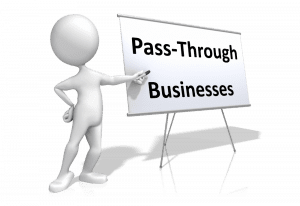 Pass through businesses are the most common form of business entity utilized by closely-held and family-owned businesses. The number of pass-through entities has continuously increased over the last 30 years, while the number of traditional C corporations has steadily decreased. Currently, pass-through businesses make up approximately 94% of all businesses in the United States. Additionally, pass-through businesses earn more than 64% of all net business income, employing more than half of all workers in the private sector.
Pass through businesses are the most common form of business entity utilized by closely-held and family-owned businesses. The number of pass-through entities has continuously increased over the last 30 years, while the number of traditional C corporations has steadily decreased. Currently, pass-through businesses make up approximately 94% of all businesses in the United States. Additionally, pass-through businesses earn more than 64% of all net business income, employing more than half of all workers in the private sector.
Basic types of pass-through business entities
A sole proprietorship is an unincorporated business, owned by a single individual, which reports its income on schedule C of the 1040 tax form. Similarly, a partnership is an unincorporated business with multiple owners, either individuals or other businesses. Limited-liability companies ("LLCs") are businesses that have limited liability like a traditional C corporation. An S Corporation is a domestic corporation that can only be owned by U.S. Citizens and can have up to 100 shareholders. It cannot be owned by other corporations or partnerships.
What makes a business "pass-through?"
These entities are called pass-through businesses because their profits (or losses) are passed directly through the business to the owners and are taxed on the owners’ individual income tax returns. On the other hand, a traditional C corporation pays taxes at the entity level, through the corporate income tax. The owners or shareholders, also pay taxes on the same income when they receive a dividend or sell their stock and realize a capital gain. Another difference between pass-through businesses and traditional corporations is that owners pay the full tax on their business income each year, as the income is being earned. Whereas, the owners of a traditional corporation are allowed to defer taxation under certain situations.
Liability for pass-through businesses
While most LLCs are taxed as partnerships, an LLC can elect to be taxed as a corporation. True partnerships are very similar to LLCs, with one important difference -- a partnership must have at least one partner with unlimited liability for the partnership’s actions and unpaid liabilities. In general partnerships, on the other hand, all members have unlimited liability. For this reason, LLCs have replaced most partnerships, as the chosen business entity when forming a pass-through business.
How S corporations work
A S corporation is most often treated like an LLC for the purpose of income taxes. However, the payroll taxes imposed on an S corporation are usually lower than other companies. After payment of a reasonable salary is made to a shareholder or an employee of an S corporation, any additional distributions to that employee are not be subject to payroll taxes or the self-employment tax. On the other hand, the ordinary income of a working LLC member or partner is generally subject to the self-employment tax.
If you are starting a business and have questions regarding which entity structure is best for you, please contact Jerry Dorn at Anderson, Dorn & Rader, Ltd., either online or by calling us at (775) 823-9455.




